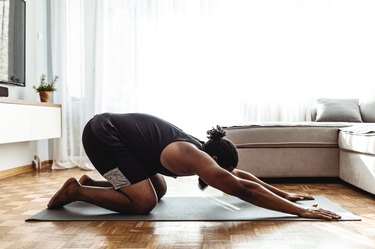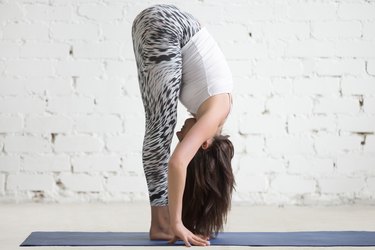
You'd be hard-pressed to find a yoga class that doesn't feature mountain pose (tadasana). This foundational pose is a staple in most yoga styles, like Vinyasa, Hatha and Bikram.
Because you're bound to encounter mountain pose in your yoga practice, why not familiarize yourself with it? Read on to get the scoop on what the pose entails, the benefits of perfecting it, common mistakes to avoid and its many variations.
Video of the Day
- What is mountain pose? Mountain pose is a foundational standing yoga pose that’s used to prepare for most standing asanas (poses), says yoga teacher Darnell Cox, RYT-500. It involves standing upright with your toes pointing straight ahead, arms at your sides and palms facing forward.
- What muscles does mountain pose work? Mountain pose is used to ground yourself and prepare for other poses — it isn’t intended as a muscle-strengthening pose. However, when you perform mountain pose correctly, it does engage a range of muscle groups, including your legs, core, back, glutes, ankles and feet, says yoga teacher Kate Ingram, RYT-500.
- Who can do mountain pose? Everyone can do mountain pose. This is because it can be easily modified according to ability and can be practiced standing, seated or even lying down, Cox says.
- How long should you hold mountain pose? “I like to give myself at least three to five slow, deep breaths in this pose,” Cox says. You can hold it much longer, but three to five breaths is roughly how long it takes for your body to settle into the pose, she adds. Note that faster-paced yoga styles like Vinyasa may have you hold the pose for only one breath, but it depends on the teacher and class focus.
How to Do Mountain Pose With Proper Form
- Stand with your feet together (or widen to hip-width for added stability) and arms at your sides. Turn your palms so they face forward.
- Keeping a slight bend in your knees, actively press down into all four corners of your feet while lifting up through your arches.
- Engage your quadriceps (the muscles in front of your thighs) and imagine lifting your thighs off your kneecaps.
- Draw your lower ribs in slightly toward your front hip bones as you reach the crown of your head toward the ceiling.
- Relax your shoulders down and away from your ears.
- Soften your gaze.
- Take at least three to five slow, deep breaths.
Tip
Keep your muscles active and engaged in mountain pose; don’t stand passively. Staying active ensures you reap the most benefits from the pose.
4 Mountain Pose Benefits
1. It Improves Posture
Mountain pose promotes good posture because it requires stacking your ankles, knees, hips and shoulders to align your spine correctly, Ingram says.
It also asks you to be aware of maintaining this body positioning at all times — something we don't typically do during a normal day.
In addition, mountain pose strengthens the muscles we rely on to maintain healthy posture while standing, sitting and moving, says Amy Sullivan, RYT-200, a registered yoga teacher and instructor with CorePower Yoga in Los Angeles.
Training these muscles to support you in mountain pose will make them better equipped to prop you up off the mat.
2. It Builds Balance
All of that body awareness in mountain pose offers balance pay-offs. As you hold mountain pose, you'll likely make small adjustments, like shifting your weight so it's more evenly distributed in both feet or centering your hips over your ankles.
"We constantly make small adjustments to maintain balance throughout the day, but we aren't generally paying attention," Ingram says.
By focusing your attention during mountain pose, you can become more aware of your alignment outside yoga practice, improving balance.
Plus, mountain pose strengthens your foot and ankle stabilizers, says Anna Passalacqua, C-IAYT, a certified yoga teacher and yoga therapist at Breathing Deeply. These are small muscles in your feet and ankles that help them stabilize when standing and moving and play an important role in balance.
3. It Helps You Prepare for Other Yoga Poses
Mountain pose is foundational, which means it's the place more challenging standing poses, like warrior pose (virabhadrasana) or chair pose (utkatasana) are built on.
"You can't move onto these other poses if you're unable to perform mountain pose and have great alignment and balance," Ingram says.
4. It Boosts Confidence
Performing open, expansive yoga poses, like mountain pose, can increase energy and self-esteem due to the grounding nature of the pose. As Sullivan explains, grounding is a sensation you feel as you root into the mat with your feet.
"As you physically ground yourself, your body starts to feel sturdy and stable, leading to feelings of calm and confidence," she says.
Common Mistakes and How to Fix Them
1. Arching Your Lower Back
Many people make the mistake of arching their lumbar (lower) spine and popping their rib cage out while standing in mountain pose.
This adds weight and pressure to the lumbar spine, which increases your risk of pain and injury, Cox says.
Fix It
Focus on drawing the bottom of your rib cage toward the front of your hip bones as you push down evenly through your feet and reach the crown of the head toward the ceiling.
“This allows the spine to grow taller and increases blood flow to the vertebrae,” Cox says.
2. Remaining Passive
Mountain pose is a deceptively active pose, according to Cox. It requires engaging several muscle groups to lift and lengthen your body.
But if you let those muscles slack off, you're more likely to sit heavily into your joints, Cox explains. This puts strain on them, which increases your risk of pain and injury.
Plus, standing passively robs you of the many benefits of mountain pose.
Fix It
Pay attention to what’s going on in your body while you’re in the pose.
“Concentrate on elongating the body by pushing the feet into the ground and lengthening the spine,” Cox says.
3. Distributing Your Weight Unevenly
Hard as you might try, chances are you tend to favor one side of your body over the other. This unconscious bias may cause you to distribute your weight unevenly between your feet, sending your posture into misalignment, Sullivan says.
Fix It
Sullivan instructs her students to lift their toes in mountain pose. While here, notice the sensation of your weight pressing evenly across the ball of each foot, and evenly between the ball of each foot and heel. Feel your quadriceps engage as you press into the mat with your feet.
“Now keep this feeling as you lower onto your toes,” Sullivan says.
3 Mountain Pose Variations
1. Reclined (Lying) Mountain Pose
To make mountain pose easier, do it in a lying position. Reclined (lying) mountain pose is also a great way to prepare for other lying yoga poses.
- Lie face-up on your mat with your legs extended and arms at your sides. Turn your palms so they face upward.
- Don’t press your lower back into the mat; let your spine settle into its natural curve.
- Flex your ankles so your toes point toward the ceiling; press your heels into the floor.
- Engage your quadriceps and imagine lifting your thighs off your kneecaps.
- Draw your lower ribs in slightly toward your front hip bones as you reach the crown of your head toward the opposite wall.
- Relax your shoulders down and away from your ears.
- Soften your gaze.
- Take at least three to five slow, deep breaths.
2. Seated Mountain Pose
If you can't perform mountain pose in a standing position, are preparing for seated yoga poses or prefer to work on your posture on the ground, give seated mountain pose a try.
- Sit on your yoga mat and extend your legs in front of you and arms at your sides. Let your palms rest on the mat.
- Flex your ankles so your toes point toward the ceiling; press your heels into the floor.
- Engage your quadriceps and imagine lifting your thighs off your kneecaps.
- Draw your lower ribs in slightly toward your front hip bones as you reach the crown of your head toward the ceiling.
- Sit tall and relax your shoulders down and away from your ears.
- Soften your gaze.
- Take at least three to five slow, deep breaths.
3. Mountain Pose With Yoga Block
You can take mountain pose up a notch by squeezing a yoga block between your thighs. This activates your hip adductors (the muscles along your inner thighs), which helps to engage your core muscles, Cox says.
- Stand with your feet hip-width apart and place a yoga block between your thighs. Let your arms hang at your sides and turn your palms so they face forward.
- Keeping a slight bend in the knees, actively press down into all four corners of your feet while lifting up through your arches.
- Squeeze the yoga block in between your thighs, engage your quadriceps and imagine lifting your thighs off your kneecaps.
- Draw your lower ribs in slightly toward your front hip bones as you reach the crown of your head toward the ceiling.
- Relax your shoulders down and away from your ears.
- Soften your gaze.
- Take at least three to five slow, deep breaths.


